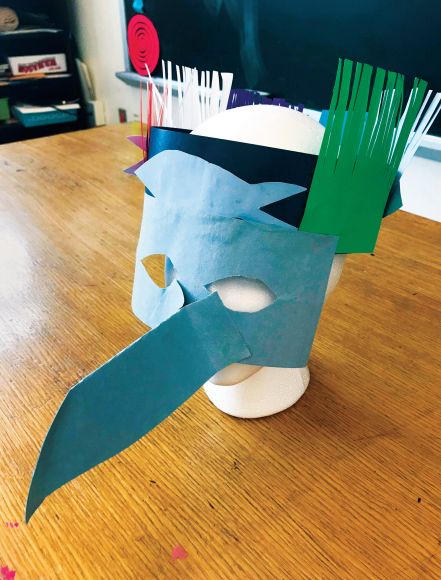 Fifth-grade student Darian’s headpiece was inspired by the Great Blue Heron. The fish at the top of the mask represents the choice of food for that species of bird. Fifth-grade student Darian’s headpiece was inspired by the Great Blue Heron. The fish at the top of the mask represents the choice of food for that species of bird. |
|
In this lesson, students created bird headdresses based on research about local bird species, participated in an urban bird count, and presented their work at a local community outdoor festival.
Connecting
Fifth-grade students learned about Pennsylvania native bird species through an in-class presentation of bird mounts from a local environmental education center. As a way to enhance personal connections, each student received an envelope containing pictures and facts about one specific native bird species. Using a brainstorming worksheet, students wrote down several facts about their bird’s habitat, nesting and eating habits, and physical features such as beak and feet characteristics along with the bird’s distinctive colors and patterns. Students also researched the symbolic meanings of birds found in several different types of cultures.
Creating
After researching their birds, students created a headdress using 3D paper techniques to build layers representing both the physical qualities of the bird and symbolic and personal meanings. Throughout the making process, images of local birds along with audio of bird songs were featured on the whiteboard.
Connecting and Presenting
After the projects were completed, students joined members from the Audubon and Lehigh Gap Nature Center on an Urban Bird Count on and around the school property. Students also were invited to attend the Step Outdoors Festival sponsored by the Bethlehem Arts- quest, a nonprofit organization focused on providing art, culture, and educational programs for the local region.
Developing an Outdoor Classroom and Nature Trail
Adorned in their bird headdresses and led by their teacher, Ms. Anderson, students hiked and discovered more about the forested land surrounding their school located in the heart of the city. Ms. Anderson’s love of nature and background in environmental education inspired the idea of creating a nature trail and outdoor classroom. She advocated to her principal how the building of an outdoor classroom and nature trail would foster empathy for nature and discussions on sustainability. She pursued and was awarded a grant to build a nature trail and outdoor classroom on the school property.
Ms. Anderson’s care and connection to nature fostered this same care and concern in her students. Their time together outdoors built ongoing and frequent connections to nature such as gathering natural materials for lessons, examining invasive bug species, and making connections to students’ previous homes and natural environments in Florida and Puerto Rico.
 Students were led on a birdwatching hike on and around school property, hosted by the local nature conservancy and members of the Audubon Society. Staff from Artsquest of Bethlehem also joined students on the hike.
Students were led on a birdwatching hike on and around school property, hosted by the local nature conservancy and members of the Audubon Society. Staff from Artsquest of Bethlehem also joined students on the hike.
Sustainability and Empathy
Through researching their birds, students also connected bird migration to their own experiences of migrating from other states and countries. All of these examples connect to the Center for Ecoliteracy’s belief in the value of conversations on sustainability and therefore empathy for nature by experiencing the natural world and knowing well the places we live.
Caring for others is also connected to our care for where we live. The personal and symbolic connections students made through their bird head- dresses moved beyond the classroom to a nature trail and community festival, fostering a visible link to humans, animals, and the natural world.
Tiffany Anderson is an art teacher at Donegan Elementary School in Bethlehem, Pennsylvania. tanderson@basdschools.org
Amy Pfeiler-Wunder is professor of art education at Kutztown University of Pennsylvania. wunder@kutztown.edu
NATIONAL STANDARD
Connecting: Relating artistic ideas and work with personal meaning and external context.
WEB LINKS
ArtsQuest
Center for Ecoliteracy
View this article in the digital edition.


 Fifth-grade student Darian’s headpiece was inspired by the Great Blue Heron. The fish at the top of the mask represents the choice of food for that species of bird.
Fifth-grade student Darian’s headpiece was inspired by the Great Blue Heron. The fish at the top of the mask represents the choice of food for that species of bird. Students were led on a birdwatching hike on and around school property, hosted by the local nature conservancy and members of the Audubon Society. Staff from Artsquest of Bethlehem also joined students on the hike.
Students were led on a birdwatching hike on and around school property, hosted by the local nature conservancy and members of the Audubon Society. Staff from Artsquest of Bethlehem also joined students on the hike.